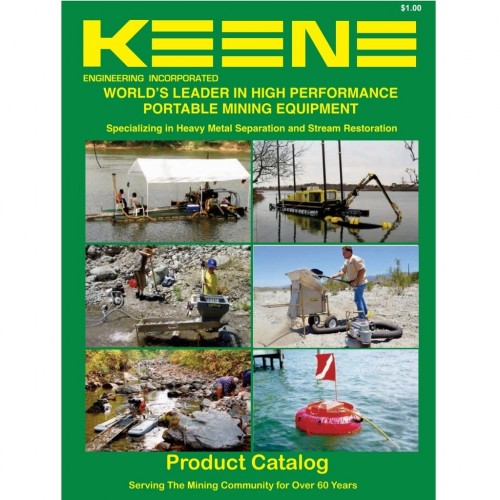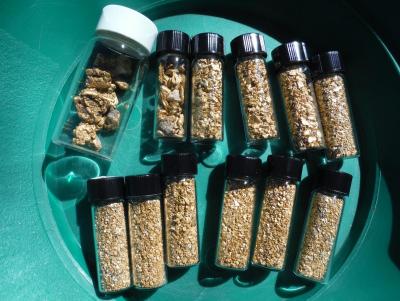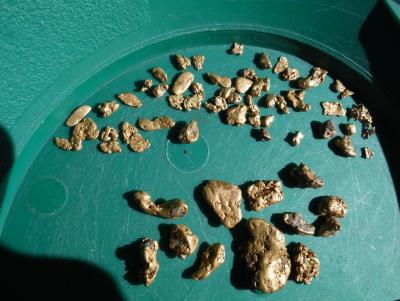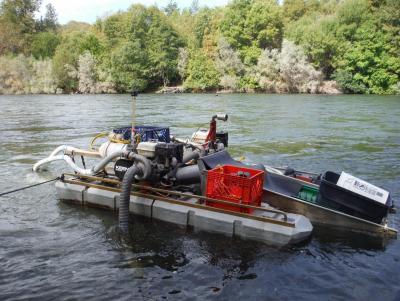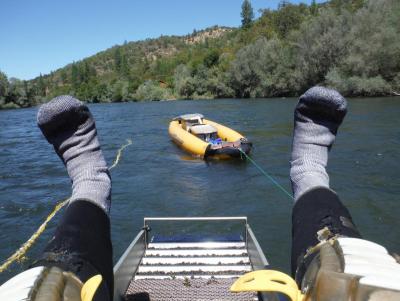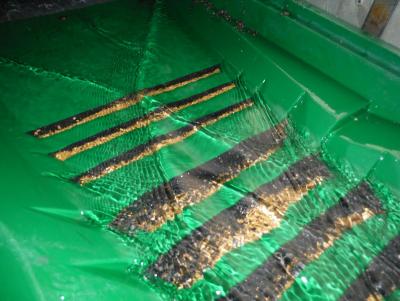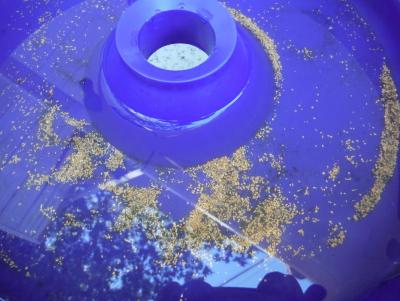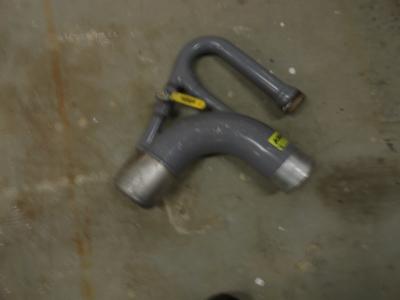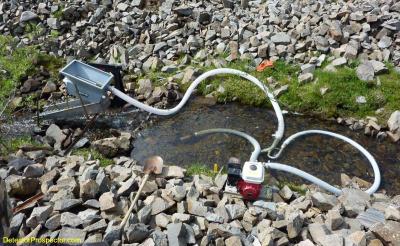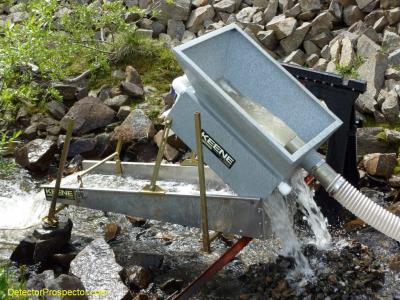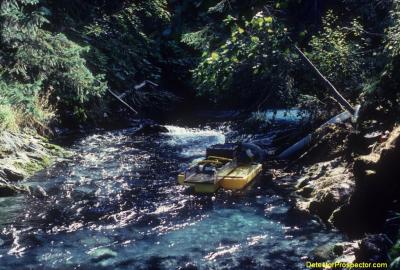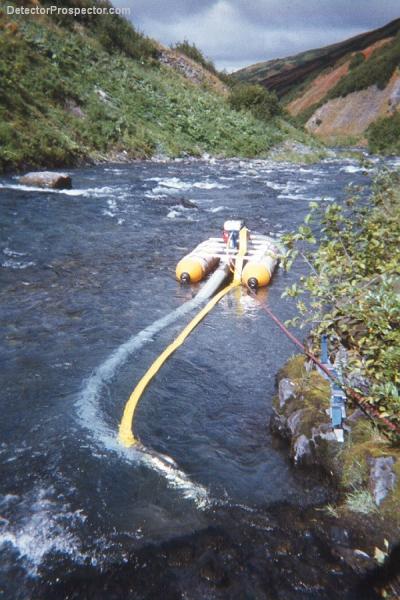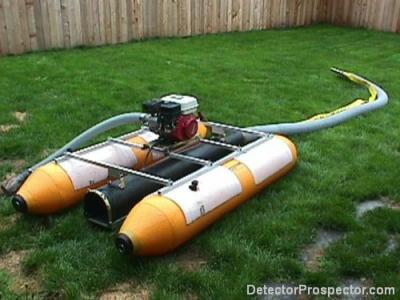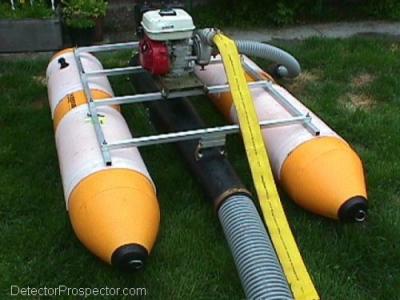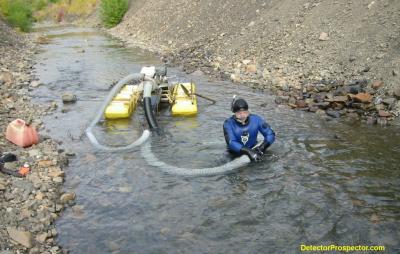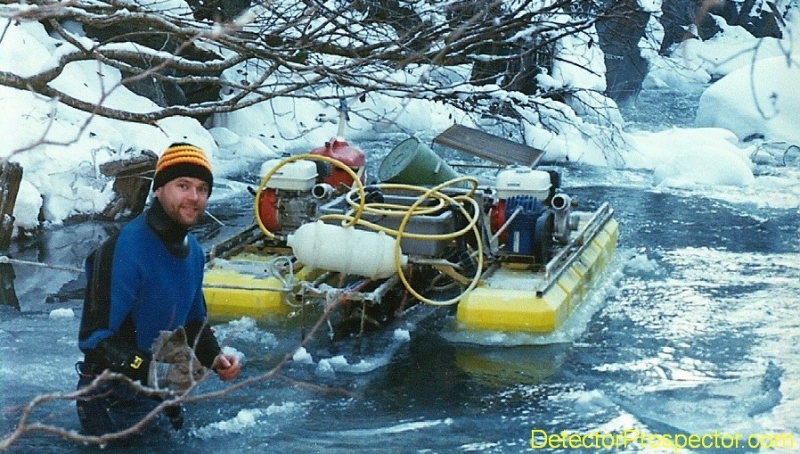Search the Community
Showing results for tags 'gold dredging'.
-
-
Hey Steve, Just finishing up my gold dredging season and catching up on your Alaskan trip. What a great story...went through all pages. Nice gold too! Good job man! That is a tough way to get gold - but almost more satisfying due to the effort you have to go through to get it. Here are some pics of my dredge season and gold. My mining partner and I got 31 oz's of beautiful Oregon gold! I got just under half of the take... Couple pics of a bonaza Le Trap sluice cleanup, and nice blue bowl cons and me at lunch atop my dredge (shore was too far to get back to until end of day, dragging the dredge back under water 150 feet to shore). My detecting season starts now! - hope to get some nice detecting nuggets like yours! Take care, Alan
-
So I have this idea to build a 4 inch sub surface dredge. I have all the parts and pieces with the exception of the pump and moter (in route). Well spring fever is kicking in and I plan to assemble this dredge. I am currently engineering the frame work. My question here is all the pictures I have seen show the dredge tube dead center in between the floats and looks to be level with the floats. Should the tube be suspended lower in the water or submerged completely? Just for reference the setup consists of. 1. Keene 4 inch tube. 2. 15 foot of 4 inch suction hose. 3. 4 inch nozzle. 5. 20 foot 2 inch pressure line. Hard line not lay flat. 6. Keene 3 inch mini floats. 7. Keene P180 Pump and a Kohler Command Pro 7 hp motor. 8. No air on this one. 9. 1 inch box aluminum frame work. Also I found a great deal on a Hydro Force nozzle. Anyone have any thoughts on these?
-
I was involved in some validity exam testing on some mining claims in Alaska a few years ago. Short story is samples had to be taken at various locations to prove the claims have paying quantities of gold. Any claims not passing the exam would be lost. This photo was taken on Skookum Gulch in the Wrangell Mountains of Alaska. It is a small short drainage but was very rich at one time. It was mined out by hand as the stacked rocks reveal but some gold still remains. In this case we used a Keene 175-30 highbanker / dredge combo for the test work. The creek is very small and so had to be ponded up for the system to work, and it used nearly all the water in the creek while operating. The little gulch almost goes dry later in the season. One interesting note is that we left the highbanker stored upright over the winter. Water entered the tops of the leveling legs, which are hollow steel tubes with feet welded on the bottom. The water froze over the winter, and because the legs were stowed in there shortest configuration it proved impossible to extend a couple of them. And believe me there was a lot of squeezing in a vice and pounding of hammers involved! The metal had warped out to the point it was impossible to squash back down small enough to pass through the bracket hole. We just gave up and jury rigged this little saw horse and fence post system you see here. The legs were later replaced and drain holes drilled at the bottom of all the legs to allow them to drain in the future to prevent this from happening. The amount of gold found was marginal and last I heard the disposition of this particular claim was in question. It was a fun project though and a nice photo of how a highbanker / dredge combo can be put to use.
-
This one sure brings back nice memories! My old Keene 5" dredge parked on lower Stetson Creek on the Kenai Peninsula, Alaska in 1979. The first of many years dredging on this creek and on Cooper Creek, which Stetson feeds into. This was one of my more pleasant summers of dredging. The weather was nice, the water was low, the gold was good. This location was giving up about an ounce a day, better than the average on Stetson Creek. Mainly because of plentiful shallow bedrock. The gold is almost all on bedrock in Stetson Creek with little or nothing in the overburden. The more overburden you process, the less gold you get overall as a rule. This is because Stetson Creek is a classic gulch deposit, a very steep creek with waterfall after waterfall. Mother nature's giant sluice box, and the gold has been well settled and concentrated. The paystreaks were small and very well defined, move over just a foot and it was like crossing a line, you were in the gold and now you are out. There were large stretches of creek with smooth bedrock and so little gold you would think there was none in the creek if you got into one of those sections. The gold was nice - lots of jewelry gold buy nothing really big. The two pennyweight nugget in the photo was about as large as I ever found in years of mining, though the records report a three ounce nugget having been found on the creek. Must of been a fluke from what I saw, if it even happened at all.
-
This is an interesting dredge. I was really into subsurface dredges for portability. Keene for a brief time sold a set of inflatable pontoons, so I got a pair and in 1999 put this 5" subsurface dredge together. The frame was homemade out of stock aluminum, and the pontoons were held in place with plastic drums I split in half length-wise. The tube was a standard Keene 5" subsurface dredge tube of the time. The old black marlex version was a pain because the tray clipped on at the forward end. I had to reach into the middle of the assembly to release the clips, and then the tray would drop down in front. In current this was a problem for sure as the current would want to grab the tray and knock it down. The later granite gray marlex tubes were improved with the release clips at the rear, which were easy to grab from the back of the dredge. The rear of the tray would drop down and was easily slid out to the rear. Much better. 5.5HP Honda powered Keene P-180 pump with 5" suction nozzle. Nice dredge, very compact and light-weight. This was on the Mills Creek Cooperative claims on upper Mills Creek on the Kenai Peninsula of Alaska. We got a lot of nice gold in the stretch in the picture as a narrow canyon widened out at this point. Bob(AK) is a member of the forum, and he also did very well here. Another couple photos of the dredge taken with the crappy digital cameras of the day while being built in my back yard.
-
I visited Ganes Creek, Alaska many times over the years. This was always to metal detect for gold in my case. However, there were others who wanted to suction dredge while at Ganes Creek. My friend Brian Berkhahn was one of them. Brian just loves dredging. Detecting he is good at but has less patience for. So in 2002 while we were at Ganes on a nugget hunt Brian talked Doug into letting him use a 5" Keene dredge they had at the mine. There was a drainage ditch upstream where several large nuggets had been found in the pile of material dug out of the ditch. I was a bit skeptical as the nuggets in the tailings are few and far between, but Brian wanted to give it a go. As I recall he did not find much here, but he does have the distinction of being one of the few guys who have done some dredging at Ganes Creek. He is on the forum so maybe he will chime in with his recollections on this photo.
-
I was really heavy into very late fall and very early spring dredging in the late 90's time frame. This photo is from 1996 and was taken by my friend Rich Lampright. I worked a lot at Crow Creek Mine, which is glacial fed. It runs very high and fast in the summer when the glacier is melting. The best time to dredge is in the winter months when freezing temps bring the water levels down by over 50% and the water starts running crystal clear. It also made for some very cold dredging at times, but properly outfitted with a good drysuit you can stay surprisingly comfortable. Usually. Funny how some days I really was cozy and others it was just plain cold. I could operate well down to about 15 degrees. Below that, and the water literally froze in the sluice box while it was running. I resorted to subsurface dredges for the coldest spells as the box being underwater did not freeze up. But even then you see weird stuff. Ice crystals floating in the water build like snow drifts of slush behind rocks on the bottom, and giant balls of slush form on the pump intakes, eventually plugging them. Why suffer this you ask? I was seeing multi-ounce days working by myself. I took a lot of gold out of Crow Creek; even after paying a percentage to the owners it was good. In fact the best dredging I ever did. My best day in there working a 6" by myself was over 8 ounces of gold. This was my favorite dredge, my old Keene 6" with twin Honda 6HP pumps. This model was made with a molded marlex powerjet in two pieces - the jet and the flare. The jet and flare assembled was about six feet long but I could just toss it over my shoulder and carry it in one piece it was so light. The dredge had a stout frame with a lever handle leveling system, far superior to the later slide the box back and forth nonsense. The box was a well built single run sluice that I preferred over later double-decker designs. I never should have sold it. I did however, to Brian Berkhahn, and he also got a lot of gold with it. And I know he now also regrets selling it. It was the best Keene dredge I ever owned. Mark Keene told me they stopped making the marlex jets due to a high failure rate with the process but they should have either fixed the process or just charged more to make up for the failures. It was an incredible advance in the technology, and amazingly after all the years of use the inside of that jet never showed more than light scuffing. I think it was actually more durable than steel jets. This photo is first thing in the morning, breaking away all the ice that has formed around the dredge overnight.
-
My first gold dredge! After seeing a guy running a suction dredge at Crow Creek Mine south of Anchorage, Alaska I ordered my first dredge in early 1973. I had never seen a dredge before, and this guy was wearing a wetsuit running a 4" dredge about chest deep in the water. He saw my interest and shut the dredge down, pointed at the first riffle, and there was more chunky gold than I had ever found. I was hooked! I got the dredge direct from Keene, only way I could get one back then. Knowing nothing about dredges I saw no reason why I should spend extra money to get floats. I figured 2.5" was too small and 4" too big so a 3" must be just right. I learned a lot with that dredge. The first thing I learned is when you put it on bank with powerjet way above water it is nearly impossible to prime. And that when you finally get it primed, the entire hose will fill with gravel, then everything stops. Once I took the 15 feet of hose off to shake all the gravel out, and did this maybe three times in a row, I realized the dredge cannot be operated more than a couple feet above water. In fact, keep the place where hose and jet meet at or below water level for best results. Which made finding a place to use it quite a challenge. You need something like in this photo - a nice rock or pile of rocks or sawhorses next to water. This basically eliminated almost all the places I wanted to use the dredge, so this photo was the last time I ever dredged without floats, way back in 1973. You pretty much have to have them as a suction dredge that does not float is very limited. I did not find a lot of gold here but found my biggest nugget to that date. I think it was only like a pennyweight but it seemed huge at the time. Photo taken in Wrangell Mountains, Alaska on Skookum Gulch.




